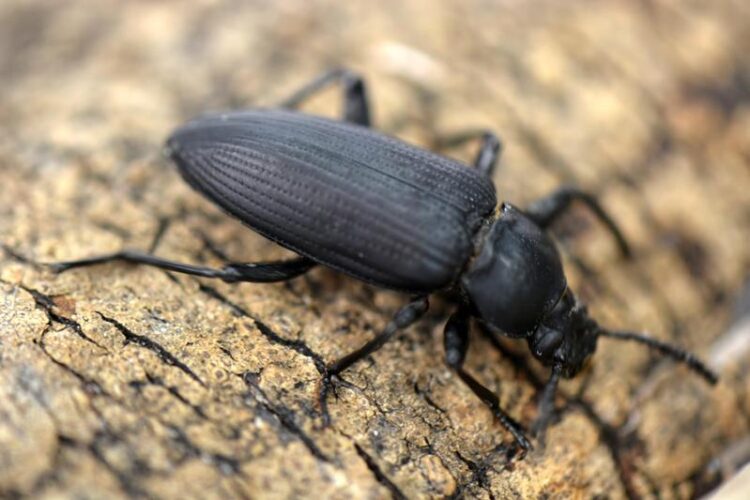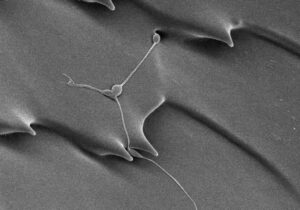Powerful lubricant protects beetle joints from wear and tear

A special challenge for wear: Unlike vertebrates such as humans, the joints of insects are open and not surrounded by a protective capsule.
Foto: Konstantin Nadein
Zoologists at Kiel University study special characteristics of insect joints.
Knee or wrist joints of vertebrates including humans are surrounded by a protective capsule. It contains a fluid that minimizes friction between the cartilages and thus enables bending and stretching of arms and legs. Insect joints are designed completely different: Instead of cartilage they consist of a supportive exoskeleton and without any encapsulation their joints are exposed to numerous environmental challenges. A research team from the Institute of Zoology at Kiel University (CAU) wants to find out how these open joints of insects work and has studied the knee joints of the darkling beetle Zophobas morio. They discovered a semi-solid lubricant that minimize friction similarly to Teflon, thereby reducing wear in the leg joints. The research team recently presented its findings in the journal Proceeding of the Royal Society B.

© Konstantin Nadein
Running, flying, jumping, digging, climbing – the different insect species use their legs and, correspondingly joints, for a range of activities. “But we almost know nothing about the materials, surfaces and lubricants in these joints” says Stanislav Gorb, professor of functional morphology and biomechanics at CAU. Dr. Konstantin Nadein, member of his team, wants to find out how insect joints work without a protective capsule. In his current study, he examined the knee joints of the darkling beetle Zophobas morio, a beetle species about two centimeters in size that is found primarily in Central America, Cuba and parts of South America. Using a scanning electron microscope, the biologist discovered countless fine pores, each just a micrometer in size, on joint’s contact surfaces. They extrude flows of a semi-solid substance, some of which mostly broke apart in numerous small fragments.
Insect lubricant with friction-reducing properties similar to Teflon
The research team assumed that this substance is serving as a lubricant between contacting surfaces. To verify this, they collected the substance and applied it between two glass surfaces. With the help of Dr. Alexander Kovalev, they measured frictional forces in contact, when the two surfaces moved against each other. For comparison, they also tested semifluid polytetrafluoroethylene (PTFE or Teflon) which is also used as a pan coating, between glass plates. “Our experiments show that the coefficient of sliding friction is reduced in the system lubricated by the beetle substance similar to that of Teflon – the best friction reducing material we currently can produce “, Nadein summarizes the result.
The high viscosity of the substance is advantageous for the beetle joint in two ways. On the one hand, the flows and fragments work like a spacer between two solid surfaces. They prevent direct physical contact between the joint surfaces and reduce wear. Since the whole contact surfaces are covered with the pores, virtually the entire open joint is protected. Second, a liquid lubricant in an open joint would inevitably lead to its constant losses and the need for production in significant quantities.
Possible applications in microrobotics or tiny prostheses
Since the structure of the insect joints strongly resembles mechanical micro-joints and artificial micro-hinges, the properties of the organic beetle lubricant could also be interesting for technical applications. It could improve the function of microrobots or tiny prostheses, reduce wear, and thus prolong their lifetime.
To achieve this, however, a way has to be found to identify the components of the lubricant discovered in the beetle and to produce it synthetically at low cost and in larger quantities. Using infrared spectroscopy, Jan Thøgersen and Tobias Weidner from the Department of Chemistry at Aarhus University, Denmark, studied the chemical and physical properties of the substance and found out that it consists largely of proteins. However, the research team cannot yet name all the components in detail. “It is difficult to analyze the substance chemically because it hardly soluble in any liquid. In addition, we need much more material for tests, but collecting it by hand is very time-consuming,” Nadein explains.
General operating principle of insect joints
Since the legs of the large darkling beetle are not evolved to meet special capabilities such as digging or jumping, the research team assumes that the discovered lubricant could be a general operating principle of insect joints. “This is also supported by the fact that we have also found it in the knee joints of other insects, such as the Argentinean wood roach Blaptica dubia, that is phylogenetically quite distant from beetles.” More research is needed here – including on the question of how insects move their legs in detail and how they protect their open joints from contamination, for example.
This research was financially supported by the German Research Foundation (DFG) as part of the project “Functional Design of Beetle Leg Joints” to Konstantin Nadein.
Photos are available to download:
http://www.uni-kiel.de/de/pressemitteilungen/2021/213-Kaefergelenk-1.jpg
Caption: The darkling beetle (Zophobas morio) moves its knee joints without much sign of wear. © Konstantin Nadein
http://www.uni-kiel.de/de/pressemitteilungen/2021/213-Kaefergelenk-2.jpg
Caption: A special challenge for wear: Unlike vertebrates such as humans, the joints of insects are open and not surrounded by a protective capsule.
© Konstantin Nadein
http://www.uni-kiel.de/de/pressemitteilungen/2021/213-Kaefergelenk-3.jpg
Caption: Dr. Konstantin Nadein (from left), Dr. Alexander Kovalev and Professor Stanislav Gorb from Kiel University are investigating the structure-function relationship of insect joints. © Julia Siekmann, Uni Kiel
http://www.uni-kiel.de/de/pressemitteilungen/2021/213-Kaefergelenk-4.jpg
Caption: Thin strands of an unusual semi solid substance are extruded from the countless fine pores on the beetle’s joints. It reduces friction to the same extent as Teflon. © Konstantin Nadein
http://www.uni-kiel.de/de/pressemitteilungen/2021/213-Kaefergelenk-5.jpg
Caption: The flows partially break and form many small clumps. Like a cushion, they prevent direct physical contact between the joint surfaces.
© Konstantin Nadein
Wissenschaftliche Ansprechpartner:
Professor Dr. Stanislav Gorb
Functional Morphology and Biomechanics, CAU
Telefon: 49 431 880-4513
E-Mail: sgorb@zoologie.uni-kiel.de
http://www.sgorb.zoologie.uni-kiel.de/
Dr. Konstantin Nadein
Functional Morphology and Biomechanics, CAU
Telefon: +49 431 880-4517
E-Mail: knadein@zoologie.uni-kiel.de
Originalpublikation:
Originalpublikation:
Nadein K, Kovalev A, Thøgersen J, Weidner T, Gorb S. 2021 Insects use lubricants to minimize friction and wear in leg joints. Proc. R. Soc. B 288: 20211065. https://doi.org/10.1098/rspb.2021.1065
Weitere Publikation:
Nadein, K. & Gorb, S. 2021. Lubrication in the joints of insects (Arthropoda: Insecta). Journal of Zoology (Wiley) 315,
https://zslpublications.onlinelibrary.wiley.com/doi/full/10.1111/jzo.12922
Weitere Informationen:
http://www.uni-kiel.de/en/details/news/213-kaefergelenke Link zur Meldung
http://www.kinsis.uni-kiel.de/en Website KiNSIS: Understanding structures and processes in the nano dimensions and implementing the findings in an application-oriented manner is the goal of the interdisciplinary priority research area KiNSIS (Kiel Nano, Surface and Interface Science) at Kiel University.
Media Contact
All latest news from the category: Life Sciences and Chemistry
Articles and reports from the Life Sciences and chemistry area deal with applied and basic research into modern biology, chemistry and human medicine.
Valuable information can be found on a range of life sciences fields including bacteriology, biochemistry, bionics, bioinformatics, biophysics, biotechnology, genetics, geobotany, human biology, marine biology, microbiology, molecular biology, cellular biology, zoology, bioinorganic chemistry, microchemistry and environmental chemistry.
Newest articles

Innovative 3D printed scaffolds offer new hope for bone healing
Researchers at the Institute for Bioengineering of Catalonia have developed novel 3D printed PLA-CaP scaffolds that promote blood vessel formation, ensuring better healing and regeneration of bone tissue. Bone is…

The surprising role of gut infection in Alzheimer’s disease
ASU- and Banner Alzheimer’s Institute-led study implicates link between a common virus and the disease, which travels from the gut to the brain and may be a target for antiviral…

Molecular gardening: New enzymes discovered for protein modification pruning
How deubiquitinases USP53 and USP54 cleave long polyubiquitin chains and how the former is linked to liver disease in children. Deubiquitinases (DUBs) are enzymes used by cells to trim protein…



